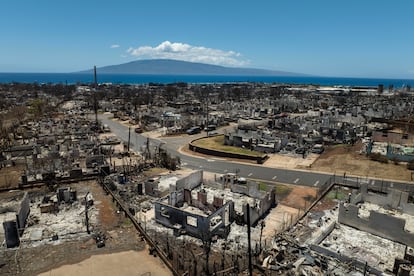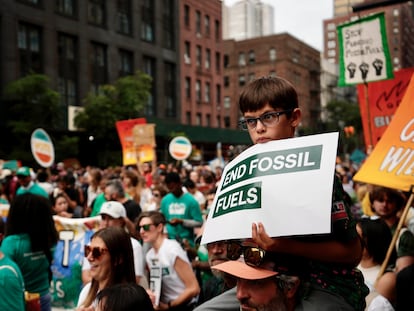Homeowners face rising insurance rates as climate change makes wildfires, storms more common
The fire that destroyed the Hawaiian community of Lahaina, as well as the historic flooding in Vermont and Maine, are recent examples of events that could drive up insurance costs for homeowners in other states

A growing number of Americans are finding it difficult to afford insurance on their homes, a problem only expected to worsen because insurers and lawmakers have underestimated the impact of climate change, a new report says.
A report from First Street Foundation released Wednesday says states such as California, Florida and Louisiana, which are prone to wildfires and damaging storms and flooding, are likely to see the most dramatic increases in premiums. But the fire that destroyed the Hawaiian community of Lahaina on Aug. 8, as well as the historic flooding that happened in Vermont and Maine in July, are examples of events that could drive up insurance costs for homeowners in other states.
“If you’re not worried, you’re not paying attention,” said California Sen. Bill Dodd, whose district includes the wine-country counties devastated by the LNU Complex fires in 2020.
First Street estimates, factoring climate models into the financial risk of properties in its report, that roughly 39 million properties — roughly a quarter of all homes in the country — are being underpriced for the climate risk to insure those properties.
“Some places may be impacted very minimally, but other places could see massive increases in insurance premiums in the coming years,” said Jeremy Porter, head of climate implications at First Street and a co-author of the report.
First Street, a New York-based non-profit, has been a to-go researcher on the financial implications of climate change for years. Their research is used by Fannie Mae, Bank of America, the Treasury Department and others for understanding the potential risks to properties.
There are several signs that climate change is taking its toll on the insurance industry. The U.S. homeowner’s insurance industry has had three straight years of underwriting losses, according to credit rating agency AM Best. Losses for the first half of 2023 totaled $24.5 billion, which is roughly what was lost in all of 2022.
“(Climate change) is a problem that is already here,” said Todd Bevington, a managing director at the insurance broker VIU by HUB. In his 30 years of doing insurance, he said “I’ve never seen the market turn this quickly or significantly.”
Skyrocketing insurance costs are a serious concern for the small town of Paradise in Northern California, which was nearly wiped out by a deadly 2018 wildfire that killed 85 people.
Jen Goodlin moved back to her hometown from Colorado with her family in 2020, determined to help in the town’s recovery. They began building on a lot they had purchased, and moved into their new house in October 2022.
In July, she was shocked to receive notice that the family’s homeowner insurance premium would be $11,245 -- up from $2,500.
“Our insurance agent said, ‘Just be thankful we didn’t drop you,’ and I said, ‘You did, you just dropped me,’” she said.
Goodlin, a former dental hygienist who is now executive director of the nonprofit Rebuild Paradise Foundation, said hundreds, if not thousands, of people are being hit by these rate hikes in a town being built with updated fire-safe building codes and little if any fuel to burn. She knows a homeowner whose premium is now $21,000 for a newly constructed home.
Record numbers of Americans are now insured through state-affiliated “insurers of last resort” like California’s FAIR Plan, or Louisiana or Florida’s Citizens property insurance companies. These programs were designed to insure properties where private insurance companies have refused to insure or the price for private insurance is too expensive.
Goodlin will soon be one of those homeowners. She said she’s in the process of transitioning to the FAIR Plan.
The number of homeowners covered by California’s FAIR Plan was 268,321 in 2021, almost double what it was five years before. That figure has almost certainly increased in the last two years, experts say. In Florida, Citizens Property Insurance Corp. now has 1.4 million homeowners’ policies in effect, nearly triple in five years.
In some cases, policymakers have bound the hands of insurance companies, leading to an underpricing of risk. For example, the most a California insurance company can raise a homeowner’s premium by law each year is 7% without involving a public hearing, a process that most insurers want to avoid. Those policies, along with the increased chance of catastrophic events, have led insurers like State Farm and Allstate to either pull out of the California market or pause underwriting new policies.
As a result, California’s FAIR plan, which was created 50 years ago as a temporary stopgap measure for those impacted by riots and brush fires in the 1960s, is now the only option available to homeowners in some ZIP codes.
“We’ve got to find a way to get insurers to get back into the market, to take people out of the FAIR Plan so that we can reduce the risk there,” Dodd said.
Dodd was one of the key lawmakers trying to negotiate a bill in the final weeks of the state’s legislative session to address the issue. But all sides failed to reach an agreement.
There are likely to be more insurance market failures in the future, Porter said, as more insurers simply refuse to underwrite policies in certain communities or go property by property. Comparisons to the National Flood Insurance Program, which is now $22.5 billion in debt, have become common.
Even the backstop programs are buckling under tremendous losses. Louisiana’s insurer of last resort, Citizens, raised its rates for 2023 by 63.1% statewide to cover higher costs.
This summer, reinsurance companies such as Swiss Re and Munich Re raised their property catastrophe reinsurance premiums in the U.S. by an average of 20% to 50%. Reinsurance brokerage firm Guy Carpenter & Co. said it was the highest increase for reinsurance rates since the year after Hurricane Katrina devastated New Orleans and the Gulf Coast.
“It’s a global problem. Virtually every geography is seeing a repricing of risk,” said Lara Mowery, global head of distribution at Guy Carpenter, in an interview.
Reinsurers step in to help cover losses resulting from a catastrophe, so regular insurance companies do not take on all of the risk. In one example of a typical reinsurance contract, a $20 million contract could require the insurance company to cover the first $10 million in claims and the reinsurer to pick up the other $10 million.
Mowery added that many reinsurance firms now have resources dedicated to studying the impact of climate change on how to price catastrophes.
There have been other factors impacting the insurance industry as well. Inflation has made the cost of repairing homes pricier and home prices remain near record levels. A labor shortage means getting damaged homes repaired may take longer, requiring insurers to pay for temporary housing for policyholders longer.
In short, an industry whose business model is calculating risk based on what happened in the past is increasingly unable to do so.
“You can no longer rely on 100 years of wildfire data to price risk when the unprecedented has happened,” Mowery said.
While the intensity of wildfires, floods and storms can vary from year to year, the trend lines in these models point to more wildfire activity as well as more intense storms, all likely to result in more catastrophic amounts of damage that insurance companies will have to cover.
Factoring in climate models and acres estimated to be burned, First Street estimates that by 2050, roughly 34,000 homes will burn down because of wildfires every year. That’s roughly the equivalent of losing the city of Asheville, N.C., every year.
Going forward, it may become more necessary for potential homebuyers to look at the cost of insuring the property they are looking at before locking in a mortgage rate, due to the potential for significant rate hikes in the future.
“It used to be homeowner’s insurance was an afterthought when you are looking at buying a property. Now you’ll really need to do your research into what risks there may be in that property in the coming years,” Bevington said.
Sign up for our weekly newsletter to get more English-language news coverage from EL PAÍS USA Edition
Tu suscripción se está usando en otro dispositivo
¿Quieres añadir otro usuario a tu suscripción?
Si continúas leyendo en este dispositivo, no se podrá leer en el otro.
FlechaTu suscripción se está usando en otro dispositivo y solo puedes acceder a EL PAÍS desde un dispositivo a la vez.
Si quieres compartir tu cuenta, cambia tu suscripción a la modalidad Premium, así podrás añadir otro usuario. Cada uno accederá con su propia cuenta de email, lo que os permitirá personalizar vuestra experiencia en EL PAÍS.
¿Tienes una suscripción de empresa? Accede aquí para contratar más cuentas.
En el caso de no saber quién está usando tu cuenta, te recomendamos cambiar tu contraseña aquí.
Si decides continuar compartiendo tu cuenta, este mensaje se mostrará en tu dispositivo y en el de la otra persona que está usando tu cuenta de forma indefinida, afectando a tu experiencia de lectura. Puedes consultar aquí los términos y condiciones de la suscripción digital.
More information
Archived In
Últimas noticias
Most viewed
- David King, chemist: ‘There are scientists studying how to cool the planet; nobody should stop these experiments from happening’
- Reinhard Genzel, Nobel laureate in physics: ‘One-minute videos will never give you the truth’
- Oona Chaplin: ‘I told James Cameron that I was living in a treehouse and starting a permaculture project with a friend’
- Mexico completes its trade shift with the entry into force of tariffs on China and countries without trade agreements
- Sinaloa Cartel war is taking its toll on Los Chapitos










































